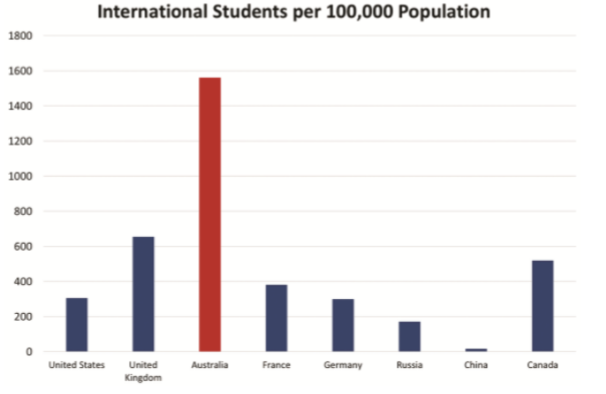May’s Four Corners “cash cows” report on Australia’s international student industry showed that universities have eroded both entry and teaching standards to entice huge volumes of lower-quality, full fee-paying international students:
“In terms of attracting international students, universities will do whatever they need to do…they are the cash cows. There is no doubt about it.” Academic
Shortly afterwards, a former Monash College English language teacher, Warwick Lough, accused universities of using dodgy English-language bridging courses to farm sub-standard international students through their degree-level courses:
“This is not a grey area. It is an absurdity that they can enter with language which is wholly inadequate,” he said…
“The assessments are carefully crafted to allow about 90 per cent of students to pass.” He said speech and writing components of the internal test were often “very carefully rehearsed”…
Professor Salvatore Babones made similar accusations in his recent seminal report for the Centre for Independent Studies.
Interestingly, a new working paper by academics from Canada’s Queen’s University Department of Economics has also raised concern that the increasing concentration of international students has caused a “progressive erosion or dumbing down of academic standards”:
…the numbers of foreign students at universities and colleges in Canada have been rising dramatically in recent years, and these raise major concerns of academic risks for the post-secondary education (PSE) sector in this country.
The international student population at Canadian PSE schools has gone up from 60 thousand in 2000 to 246 thousand in 2016 and to over 300 thousand last year…
Australia and the United Kingdom are further down this road in the burgeoning reliance of their universities on foreign students as a critical revenue stream, and we can learn from their experiences and warnings. About 13 percent of university students in Canada are international students, while in Australia and the U.K. the proportions are 25 percent. Indeed, at several of Australia’s universities, the proportion of foreign students is well above 40 percent. Increasing the numbers so rapidly poses the issue of whether Canadian schools are reaching further down the quality barrel…
A key feature of the burgeoning inflow of foreign students is their functional fluency in English (or French) at time of arrival. If the incoming students are not reasonably fluent, they will have difficulty keeping up with the required material and especially handling written assignments. Yet the school does not want to lose a lucrative revenue stream, so there are strong incentives to accommodate such limitations and water down performance requirements (e.g., allowing substitute requirements for tests and rewrites, group assessment and multiple-choice exams, grading students on a curve, inflating grades, and administrative officials over-riding instructors’ grades), so there is a progressive erosion or dumbing down of academic standards…
Such heavy reliance on revenue from foreign students can result in prioritizing the “success” of foreign students over the education and training of domestic students and domestic educational and labour market needs…
Many schools use foreign recruitment agents who are paid on a commission basis, thus providing opportunities and incentives for fraudulent claims and language test results. Some universities in Australia have also set up separate foreign student preparatory programs or “bridging courses” (at hefty fees to the universities) which then allow “graduates” to by-pass the regular admission requirements…
These developments have a statistically significant deleterious spillover effect on the general quality of education provided to the student body as a whole – domestic as well as foreign students…
The bottom line is that such heavy reliance on revenue from foreign students can result in prioritizing the “success” of foreign students above the education and training of local students. This may imply that domestic Canadian students lose out in the terms of both the quality of education, training and available curriculum; degrees at Canadian universities lose their value, and the reputation of Canadian schools decline; and the skills/training of graduating students are less of a match for Canadian economic policy and domestic labour market needs…
It is worth pointing out that Australia has roughly three times the concentration of international students as Canada:

Therefore, any concerns about Canada’s international student industry must be magnified for Australia’s, which has completely sold its soul for short-term profit.

